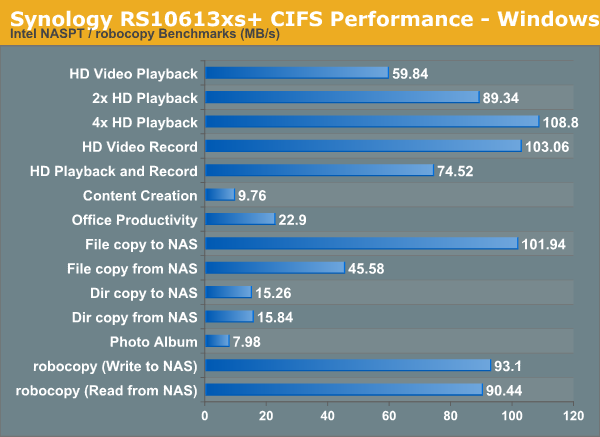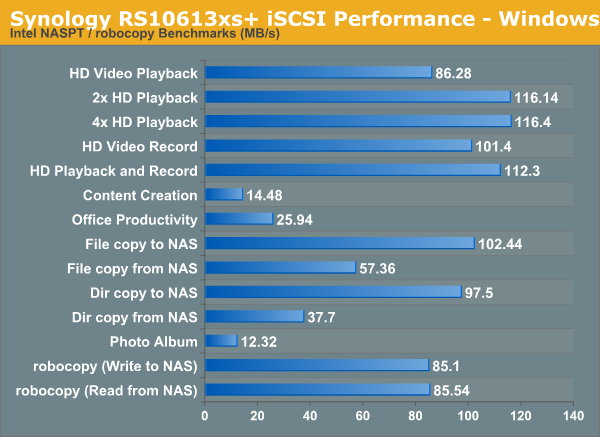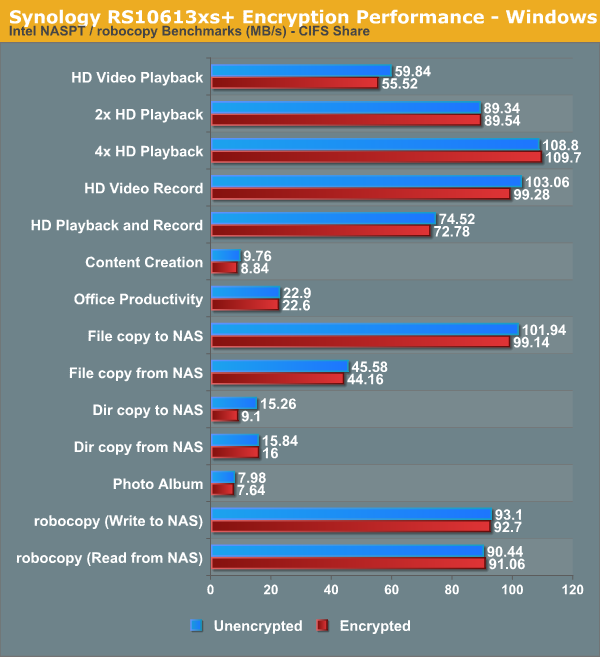Synology RS10613xs+: 10GbE 10-bay Rackmount NAS Review
by Ganesh T S on December 26, 2013 3:11 AM EST- Posted in
- NAS
- Synology
- Enterprise
Single Client Performance - CIFS and iSCSI on Windows
The single client CIFS performance of the Synology RS10613xs+ was evaluated on the Windows platforms using Intel NASPT and our standard robocopy benchmark. This was run from one of the virtual machines in our NAS testbed. All data for the robocopy benchmark on the client side was put in a RAM disk (created using OSFMount) to ensure that the client's storage system shortcomings wouldn't affect the benchmark results. It must be noted that all the shares / iSCSI LUNs are created in a RAID-5 volume.

We created a 250 GB iSCSI target and mapped it on the Windows VM. The same benchmarks were run and the results are presented below.

Encryption Support Evaluation:
Consumers looking for encryption capabilities can opt to encrypt a iSCSI share with TrueCrypt or some in-built encryption mechanism in the client OS. However, if requirements dictate that the data must be shared across multiple users / computers, relying on encryption in the NAS is the best way to move forward. Most NAS vendors use the industry-standard 256-bit AES encryption algorithm. One approach is to encrypt only a particular shared folder while the other approach is to encrypt the full volume. Some NAS vendors have support for both approaches in their firmware, but Synology only opts for the former. Details of Synology's encryption strategy can be found in this tutorial.
On the hardware side, encryption support can be in the form of specialized hardware blocks in the SoC (common in ARM / PowerPC based NAS units). In x86-based systems, accelerated encryption support is dependent on whether the AES-NI instruction is available on the host CPU (not considering units based on the Intel Berryville platform). Fortunately, the Xeon CPU used in the Synology RS10613xs+ does support AES-NI. So, we can expect performance loss due to encryption enabling to be minimal.
We enabled encryption on a a CIFS share to repeat our Intel NASPT / robocopy benchmarks. The results are presented in the graph below (with the unencrypted folder numbers for comparison purposes).

As expected, encryption carries almost no performance hit. In a couple of cases, the numbers seem to even favour the encryption case. It goes to show that the bottleneck is on the disk or network side for those cases, rather than the RAID and encryption-related computation on the NAS CPU.










51 Comments
View All Comments
Gigaplex - Saturday, December 28, 2013 - link
No, you recover from backup. RAID is to increase availability in the enterprise, it is not a substitute for a backup.P_Dub_S - Thursday, December 26, 2013 - link
Please read that 3rd link and tell me if RAID 5 makes any sense with todays drive sizes and costs.Gunbuster - Thursday, December 26, 2013 - link
Re: that 3rd link. Who calls it resilvering? Sounds like what a crusty old unix sysadmin with no current hardware knowledge would call it.P_Dub_S - Thursday, December 26, 2013 - link
Whatever the name it doesn't really matter its the numbers that count and in TB drive sizes now a days RAID 5 makes zero sense.Kheb - Saturday, December 28, 2013 - link
No it doesnt. Not at all. First, you are taking into account only huge arrays used to store data and not to run applications (so basically only mechanical SATA, that is).Second, you are completeley ignoring costs (raid 5 or raid 6 vs raid 10). Third, you are assuming the raid 5 itself is not backed up or with some sort of software\hardware redundancy or tiering at lower levels (see SANs).So while I can agree that THEORETICALLY having raid 10 everywhere would indeed be safer, the costs (hdds + enclosures + controllers + backplanes) make this, and this time for real, have zero sense.
Ammaross - Thursday, December 26, 2013 - link
"Resilvering" is the ZFS term for rebuilding data on a volume. It's very much a current term still, but it does give us an insight into the current bias of the author, who apparently favors ZFS for his storage until something he proposes as better is golden.hydromike - Thursday, December 26, 2013 - link
How many times have you had to rebuild a RAID5 in your lifetime? I have over 100 times on over 10 major HARDWARE RAID vendors."And when you go to rebuild that huge RAID 5 array and another disk fails your screwed."
The other drive failing is a very small possibility in an enterprise environment that I was talking about, because of enterprise grade drives vs consumer. That is why most have either the raid taken offline for a much faster rebuild. Besides during that rebuild the RAID is still functional just degraded.
Also my point is lots of us still have hardware that is 2-5 years old that is still just working. The newest Arrays that I have setup as of late are 20 to 150 TB in size and we went with Freenas with ZFS which puts all other to shame. NetApp Storage appliances rebuild times are quite fast 6-12 hours for 40TB LUNS. It all depends upon the redundancy that you need. Saying that raid 5 needs to die is asinine. What if the data you are storing is all available in the public domain but have a local copy speeds up the data access rates. The rebuild is faster with a degraded LUN vs retrieving all of the data from the public domain again. There are many use cases for each RAID level just because one level does not fit YOUR uses it does not need to die!
P_Dub_S - Thursday, December 26, 2013 - link
So if you were to buy this NAS for a new implementation would you even consider throwing 10-12 disks in it and building a RAID 5 array? just asking. Even in your own post you state how you use Freenas with ZFS for your new arrays. RAID 5 is the dodo here let it go extinct.Ammaross - Thursday, December 26, 2013 - link
For all you know, he's running ZFS using raidz1 (RAID5 essentially). Also, saying RAID5 needs to die, one must then assume you also think RAID0 is beyond worthless, since it has NO redundancy? Obviously, you can (hopefully) cite the use-cases for RAID0. Your bias just prevents you from seeing the usefulness of RAID5.xxsk8er101xx - Friday, December 27, 2013 - link
It does happen though. I've had to rebuild 2 servers alone this year because of multiple drive failures. One server had 3 drives fail. But that's because of neglect. Us engineers only have so much time. Especially with the introduction to lean manufacturing.RAID 5 + Global spare though is usually pretty safe bet if it's a critical app server. Otherwise RAID 5 is perfectly fine.